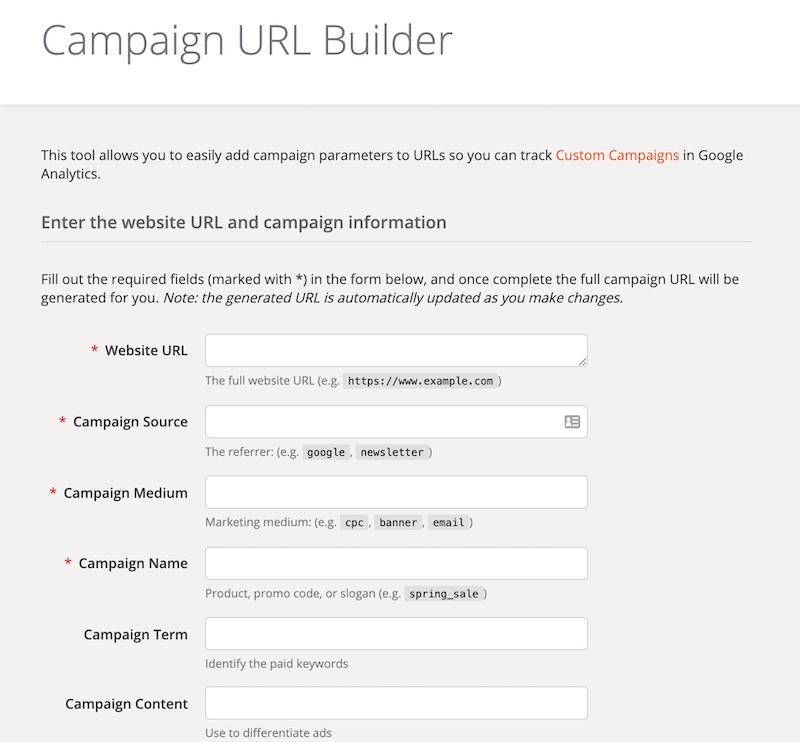

First select Acquisition-> campaign->all Campaign from the Google Analytics menu. Track campaign in Google Analytics is quite an easy process. The process to track Campaign in Google Analytics: Suppose you have two call-to-actions in the same email address, use "campaign content," and set different values for each one. It is quite helpful to differentiate between similar links and content. If you are doing paid keyword campaigning tagging manually, you should use "Campaign_Term" to specify the keyword, for example, paid keyword. It helps to identify paid search keywords. It is the advertising medium you will use to run your Campaign - for example, email newsletter, CPC, and banner. For example, Google, Facebook, and others.

UTM source parameter helps identify Campaign running platforms such as search engine, social media platform, etc. For example Christmas_Sale Campaign Source: For example Campaign Name:Ĭampaign name refers to a unique name to a Campaign that users want to run on various platforms. You can enter one URL in one line and the following URL in the next line. One can enter either one URL or more to create a campaign code. Website URL is the required parameter to generate campaign tracking code. You need to insert a few details to generate a UTM campaign (Campaign URL) to track campaign performance. Easily add campaign parameters to URLs to identify the source of leads. Necessary parameters to generate Campaign URL with UTM builder: Track your Custom Campaign in Google Analytics with our popular UTM Tag Generator. This is how AI comes for our jobs, one ChatGPT-generated slide deck.
#Utm generator code
If you still haven't added UTM code to the URL, you can even estimate your traffic but, it won't be easy to analyze its particular post-exposure, tweet, or link mainly due to the unstructured format. 17 hours ago &0183 &32 Enjoy a year of unlimited access to The Atlanticincluding every story on our site and app, subscriber newsletters, and more. If UTM appends to the specified URL, it allows you to measure traffic coming from higher granularity. UTM complete form is Urchin Tracking Module, and it is a small piece of code that appends to the end of the URL or Links. Eventually, you’ll be able to identify all traffic sources in great detail, analyze overall campaign performance and the role of each channel in your marketing mix.Let us understand what precisely a UTM is?

When clicked, these links will transmit a plethora of valuable data to your analytics tools. To sum up, UTM parameters can help you transform one single URL into dozens of trackable links. The content parameter will help you differentiate between the two links.

there’s a link to a landing page in the email body and the same email features a button with the same link). It comes in handy when the same URL is used multiple times in the same source (e.g. Utm_content is another optional parameter. While some marketers recommend reserving this parameter solely for Google Ads, others advise using it for other purposes as well, e.g., indicating Facebook headline or email subject line. Utm_term parameter is directly associated with Google Ads and is supposed to help you identify which keyword triggered the ad featuring your UTM link. A marketing campaign may be dedicated to a new product launch, seasonal sale, massive promo, or any other marketing effort. Utm_campaign is used to track which campaign the link belongs to. Values such as social, display, email, cpc, etc are normally indicated as mediums. Utm_medium stands for the marketing channel that generated user clicks. Some teams indicate Facebook and Google as traffic sources. Utm_source helps marketers track where the visitors came from-it could be a partner website, an app, a newsletter (when this is how users got on your mailing list). In addition, you can track term and content parameters. Source, medium, and campaign name are always required. There are three mandatory and two optional UTM parameters.


 0 kommentar(er)
0 kommentar(er)
